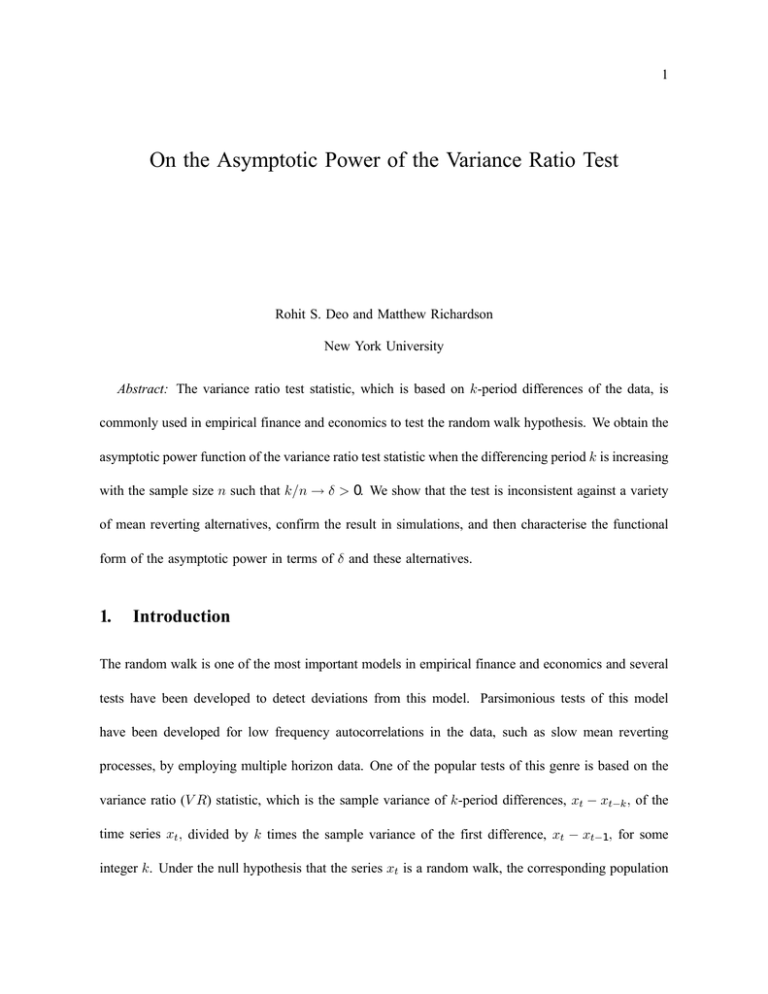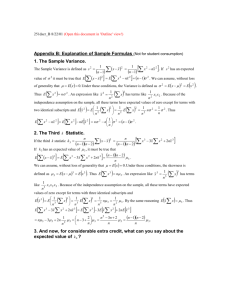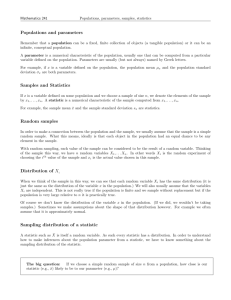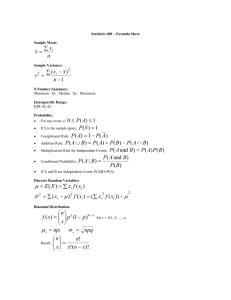On the Asymptotic Power of the Variance Ratio Test
advertisement

1
On the Asymptotic Power of the Variance Ratio Test
Rohit S. Deo and Matthew Richardson
New York University
Abstract: The variance ratio test statistic, which is based on k-period differences of the data, is
commonly used in empirical finance and economics to test the random walk hypothesis. We obtain the
asymptotic power function of the variance ratio test statistic when the differencing period k is increasing
with the sample size n such that k/n → δ > 0. We show that the test is inconsistent against a variety
of mean reverting alternatives, confirm the result in simulations, and then characterise the functional
form of the asymptotic power in terms of δ and these alternatives.
1.
Introduction
The random walk is one of the most important models in empirical finance and economics and several
tests have been developed to detect deviations from this model. Parsimonious tests of this model
have been developed for low frequency autocorrelations in the data, such as slow mean reverting
processes, by employing multiple horizon data. One of the popular tests of this genre is based on the
variance ratio (V R) statistic, which is the sample variance of k-period differences, xt − xt−k , of the
time series xt , divided by k times the sample variance of the first difference, xt − xt−1 , for some
integer k. Under the null hypothesis that the series xt is a random walk, the corresponding population
R. S. DEO AND M. RICHARDSON
2
variance ratio, given by P V R (k) = V ar (xt − xt−k ) / [kV ar (xt − xt−1 )] , is 1 for any value of k.
Arguably, the V R statistic has become the primary tool for testing the random walk hypothesis for
low frequency series. (See, for example, Campbell and Mankiw (1987), Cochrane (1988), Lo and
Mackinlay (1988) and Poterba and Summers (1988) among many others). The use of the V R statistic
can be advantageous when testing against several interesting alternatives to the random walk model,
most notably those hypotheses associated with mean reversion. In fact, a number of authors (e.g.,
Lo and Mackinlay (1989), Faust (1992) and Richardson and Smith (1991)) have found that the V R
statistic has optimal power against such alternatives.1
The practical implementation of the V R statistic is, however, less straightforward. The statistical
significance has been assessed using conventional asymptotic theory, that is, for fixed k and the
sample size n increasing to infinity. Unfortunately, the underlying asymptotic theory provides a poor
approximation to the small sample distribution of the V R statistic. In fact, rather than being normally
distributed (when standardised by
√
n), the statistics are severely biased and right skewed for large k,
which makes application of the statistic problematic. A seemingly attractive solution to this problem
is to use the result of Richardson and Stock (1989). They derived the asymptotic distribution of the
V R statistic under the random walk null, assuming that both k and n increase to infinity but in such
a way that k/n converges to a positive constant δ which is strictly less than 1. They showed that
the V R statistic, without any normalization, converges to a functional of Brownian motion. This
new distribution provides a far more robust approximation to the small sample distribution of the V R
statistic. Most current applications of the V R statistic cite the k/n → δ result as justification for
using Monte Carlo distributions (i.e., set at k = δn) as representative of the V R statistic’s sampling
distribution.
1
Richardson and Smith (1991) and Daniel (2001) explore a wider range of possible test statistics.
THE VARIANCE RATIO TEST
3
This paper provides another look at the V R statistic and its statistical properties.2 In particular,
we argue that the k/n → δ result has some very poor properties under a wide class of interesting
alternatives. Similar to the distribution under the null hypothesis of a random walk, for mean reverting
alternatives with some random walk component, the k/n → δ asymptotic theory also implies nondegenerate limiting distributions. Thus, even with a large sample size, the V R statistic should not be
expected to provide decisive evidence. Loosely speaking, in terms of the asymptotic theory, there is a
trade-off between size and power properties when using the fixed k asymptotics versus the k/n → δ
asymptotics.
The paper is organized as follows. In section 2, we define the V R statistic, review the exiting
literature on its asymptotic distribution, and provide the main theoretical result regarding its lack of
power. Section 3 then explores some of the practical implications of this result, in particular, through
simulation evidence for relevant alternative models to the random walk theory.
2.
The Variance Ratio Statistic’s Power
Given n + 1 observations x0 , x1 , ..., xn of a time series, the variance ratio statistic with a positive
integer k(< n) as differencing period is defined as
V R (k) = σ̂b2 (k) /σ̂a2 (k) ,
where
σ̂b2 (k) =
2
n
X
n
(xt − xt−k − kµ̂)2 ,
k(n − k + 1)(n − k) t=k
Perron and Vodounou (2001) also looks at the VR statitistic’s properties under the Richardson and Stock (1989)
framework. Their approach, however, is different to the extent they keep the data span, n, fixed and then take a continuoustime limit within this span. In other words, rather than assuming n → ∞, they assume the sampling frequency of the data
goes to zero.
R. S. DEO AND M. RICHARDSON
σ̂a2 (k)
4
n
1 X
=
(xt − xt−1 − µ̂)2
n − 1 t=1
and
µ̂ = n−1
n
X
t=1
(xt − xt−1 ) .
In the usual fixed k asymptotic treatment, under the null hypothesis that the {xt } follow a random
walk with possible drift, given by
xt = µ + xt−1 + εt
(1)
where µ is a real number and {εt } is a sequence of zero mean independent random variables, it is
possible to show (see, for example, Lo and Mackinlay (1988)) that
³
´
√
D
n (V R (k) − 1) → N 0, σk2 ,
where σk2 is some simple function of k. This result extends to the case where the {εt } are a martingale
difference series with conditional heteroscedasticity (see, for example, Campbell, Lo and MacKinlay
1997), though the variance σk2 has to be adjusted a little. The fixed k asymptotic distribution is well
known to fare badly when k is large relative to n. (See Lo and MacKinlay, 1989).
As an alternative to the fixed k asymptotics, Richardson and Stock (1989) develop an alternative
approach under k → ∞, n → ∞ and k/n → δ > 0 asymptotics. Under the assumption that {xt }
follows (1), where {εt } is a conditionally heteroscedastic martingale difference series, they show that
1
V R (k) →
(1 − δ)2 δ
D
Z
δ
1
(W (λ) − W (λ − δ) − δW (1))2 dλ,
(2)
where W (λ) is standard Brownian motion. Thus, while the V R statistic converges to 1 under the
fixed k treatment, here it has a nondegenerate limiting distribution. Clearly this distribution is nonnormal and instead can be characterised by a functional of Brownian motions. Through Monte Carlo
simulations, Richardson and Stock (1989) demonstrated that this alternate theory provides a much
better approximation to the small sample distribution of the V R statistic.
THE VARIANCE RATIO TEST
5
Of course, the problems of generating consistent tests when the statistic converges to a nondegenerate distribution are well known. In fact, as we show in Theorem 1 below, under a wide class of mean
reverting models, the V R statistic converges to a positive multiple of the limiting distribution in (2)
when k/n → δ > 0. This implies that the resulting test based on the V R statistic will be inconsistent
for such alternatives when k is a constant fraction of the sample size n. In practical terms, this means
that no matter how large the sample size, the probability of detecting such an alternative is bounded
below some number strictly less than one, which is clearly an undesirable property.
Theorem 1 Let {et } and {ut } be two series of zero mean independent processes with finite variance
σe2 and σu2 respectively which are independent of each other. Define the process {yt } by yt = λyt−1 +ut
where |λ| < 1. Let rt = µ + rt−1 + et and
xt = rt + yt .
(3)
Z
(4)
If k → ∞, n → ∞ and k/n → δ > 0, then
D
V R (k) →
1
(1 + λ) σe2
2
2
(1 + λ) σe + 2σu (1 − δ)2 δ
δ
1
(W (λ) − W (λ − δ) − δW (1))2 dλ,
where W (λ) is standard Brownian motion.
Proof of Theorem 1:
Let Ut = xt − xt−k − kµ̂ =
Pt
j=t−k+1 ej
− kē + yt − yt−k − kn−1 (yn − y0 ) . Thus,
[nα]
[n(α−δ)]
n
´ ky −y
X
1 X
1
k 1 X
1 ³
1
n
√ U[nα] = √
√ 0 . (5)
ej − √
ej − √
ej + √ y[nα] − y[n(α−δ)] −
n
n j=1
n j=1
n n j=1
n
n
n
By (A.6) on page 346 of Richardson and Stock(1989), for α > δ,
[nα]
1
1 X
√
ej − √
n j=1
n
[n(α−δ)]
X
j=1
n
k 1 X
√
ej −
ej ⇒ σe [W (α) − W (α − δ) − δW (1)] ,
n n j=1
(6)
R. S. DEO AND M. RICHARDSON
6
where W (α) is standard Brownian motion. Since {yt } is a stationary process, it is trivially true that
´ ky −y
1 ³
n
√ y[nα] − y[n(α−δ)] −
√ 0 ⇒ 0.
n
n
n
(7)
Hence, by (5), (6) and (7),
1
√ U[nα] ⇒ σe [W (α) − W (α − δ) − δW (1)] .
n
Furthermore, by the weak law of large numbers,
n
1X
2σu2
P
(xt − xt−1 − µ̂)2 → σe2 + V ar (yt − yt−1 ) = σe2 +
.
n t=1
1+λ
The same argument as that employed on page 329 of Richardson and Stock(1989) then yields the
required result.
Theorem 1 shows that the test based on the V R statistic when k is a fraction of the sample size
will result in an inconsistent test for mean reverting alternatives of the form (3). Such mean reverting
alternatives are of the kind often imposed in finance applications (See, for example, Poterba and
Summers (1988) and Fama and French (1988)). The variable xt contains a permanent (i.e. random
walk) component rt and a temporary (i.e. stationary) component yt . It is also obvious from (4) that
when the variance of the innovations of the temporary component, σu2 , is small relative to σe2 the test
based on the V R statistic will have power which is barely larger than the nominal size of the test in
detecting the alternative even in infinitely large sample sizes.
A limiting result for V R similar to (4) in Theorem 1 can actually be obtained under much more
general conditions on {rt } and {yt } . One can allow both the first difference series {rt − rt−1 } and
{yt } to be arbitrary stationary processes instead of the independent process {et } and the autoregressive
process of order 1 respectively that was imposed in Theorem 1. Thus, the V R statistic can be shown
to be inconsistent for a very wide range of alternatives which might be of interest in detecting mean
reversion if k is a fraction of the sample size.
THE VARIANCE RATIO TEST
3.
7
Power Implications
The theorem in Section 2 above shows that the VR statistic is inconsistent against meaningful alternatives as k → ∞, n → ∞ and k/n → δ > 0. Moreover, equation (4) provides the form for the
asymptotic power function. In this section, we explore the implications of these results for the VR
statistic’s power.
As a first step, Table 1 reports the small sample power of the VR statistic for the relevant case in
which its power is consistent. In particular, we consider the alternative model described in Theorem
1 under the assumption that σe2 = 0, that is, there is no permanent component to xt . As seen from the
table, as n increases, the power approaches 100%. Interestingly, this increase is greater for smaller δ
which is consistent with Theorem 1’s main implication that, for consistency, k/n → 0. Intuitively, in
small samples, even consistent alternatives are hard to distinguish and the large k problem is attenuated.
Table 2 reports the relevant power results for a variety of alternatives described by Theorem 1.
Several observations are in order. First, the table reports small sample power for n ranging from 60
through 2880 observations, as well as the asymptotic power level. As Theorem 1 shows, and Table 2
demonstrates, the small sample power of the VR statistic is clearly limited, supporting the inconsistency
of it as a test statistic. Second, even though there is some increase in power as n increases, the gains
are very limited for alternative specifications with substantial permanent components. For example,
when the share of the variance captured by the mean-reverting component, γ, is only 0.25 and 0.5,
respectively, the power is 14% and 38% as n → ∞. Third, these power gains are worse for larger
δ, which is consistent with the requirement that k/n → 0. As an illustration, for γ equal to 0.25,
0.5 and 0.75, respectively, the power is 14%, 38% and 86% for δ = 1/6 versus only 11%, 27% and
62% for δ = 1/3. To get a more complete picture of this point, Figure 1 graphs the three-dimensional
relation between power, γ and δ. As borne out by the figure, lower δ 0 s increase power, with varying
R. S. DEO AND M. RICHARDSON
8
impact depending on the permanent component’s importance (i.e., level of γ). For a fixed value of
γ, the drop-off in the power, as δ increases, is quite dramatic. Finally, note that the mean-reversion
parameter, λ, has no effect upon the asymptotic distribution as the VR statistic is consistent against
pure mean reversion alternatives (e.g., see Table 1). Table 2, however, shows that λ is important in
small samples.
On the one hand, these results are fairly discouraging for developing tests against slow mean reverting alternatives. Given a fixed δ, the VR statistic will have limited success. Within the Richardson
and Stock (1989) framework, however, Perron and Vodounou (2001) do manage to characterize the
maximal possible power by taking a continuous-time limit given a fixed data span, n. On the other
hand, and in contrast to the Perron and Vodounou (2001) result, Theorem 1 suggests an alternative
approach in which k is allowed to increase with n but at a slower rate. This guarantees consistency
against a wide range of alternatives. Practically, this means that, for power purposes, k cannot be too
large in small samples. The practical issue of how to then adjust the size of the statistics for a given
k in small samples remains a question for future research.
References
Campbell, J., Lo, A. and MacKinlay, A. (1997). The Econometrics of Financial Markets. Princeton
University Press, Princeton.
Campbell, J. and Mankiw, N. G. (1987). “Are Output Fluctuations Transitory?”, Quarterly Journal of
Economics, 102, 857-880.
Cochrane, J. (1988). “How Big is the Random Walk in GNP?”, Journal of Political Economy, 96,
893-920.
Daniel, K. (2001). “The Power and Size of Mean Reversion Tests”, forthcoming, Journal of Empirical
Finance.
Fama, E. and French, K. (1988). “Permanent and Temporary Components of Stock Prices”, Journal
THE VARIANCE RATIO TEST
9
of Political Economy”, 96, 246-273.
Faust, J. (1992). “When Are Variance Ratio Tests For Serial Dependence Optimal?”, Econometrica,
60, 1215-1226.
Lo, A. and MacKinlay, A. C. (1989). The Size and Power of the Variance Ratio Test in Finite Samples:
a Monte Carlo Investigation. Journal of Econometrics, 40, 203-238.
Lo, A. and MacKinlay, A. C. (1988). “Stock Market Prices Do Not Follow Random Walks: Evidence
from a Simple Specification Test”, Review of Financial Studies, 1,41-66.
Perron, P. and Vodounou, C. (2001). “The Variance Ratio Test: An Analysis of Size and Power based
on a Continuous-Time Asymptotic framework”, working paper, Boston University.
Poterba, J. and Summers, L. (1988). “Mean Reversion in Stock returns: Evidence and Implications”,
Journal of Financial Economics, 22, 27-60.
Richardson, M and Smith, T. (1994). “A Unified Approach to Testing for Serial Correlation in Stock
Returns”, Journal of Business, 67, 371-399.
Richardson, M and Smith, T. (1991). “Tests of Financial Models with the Presence of Overlapping
Observations”, Review of Financial Studies, 4, 227-254.
Richardson, M. and Stock, J. (1989). “Drawing Inferences from Statistics based on Multi-Year Asset
Returns”, Journal of Financial Economics, 25, 323-348.
0
power
8
0.2 0.4 0.6 0.
1
Figure 1: Asymptotic Power versus Gamma and Delta
0.8
0.5
0.6
0.4
gam 0
ma .4
0.2
0.2
0.3
a
delt
0.1
This figure reports the asymptotic power of the variance-ratio statistic for a test of the
random walk null against a specific alternative model at the 5% level of significance for a
range of δ’s and γ’s, where δ represents the ratio of the variance horizon to the data
length and γ represents the proportion of the variance due to the mean-reverting
component. In particular, the alternative model is x t = rt + y t where r t = rt −1 + e t ,
y t = λy t −1 + u t and
2σ 2u
γ=
.
(1 + λ )σe2 + 2σ 2u
Table 1: This table reports the power of the variance-ratio statistic for a one tailed test of
the random walk null against a variety of alternatives at the 5% level of significance for
δ = 1 / 6 and δ = 1 / 3 , where δ represents the ratio of the variance horizon to the data
length. The alternative model is x t = y t where y t = λy t −1 + u t and σ 2u =1.
n; δ = 1 / 6
60
120
180
360
720
1440
2880
n; δ = 1 / 3
60
120
180
360
720
1440
2880
λ = 0.9
7
21
47
98
100
100
100
λ = 0.9
7
21
41
90
100
100
100
λ = 0.95
4
8
11
42
94
100
100
λ = 0.95
4
8
11
34
79
98
100
λ = 0.98
3
4
4
8
22
69
98
λ = 0.98
3
4
4
5
19
47
78
Table 2: This table reports the power of the variance-ratio statistic for a one tailed test of
the random walk null against a variety of alternatives at the 5% level of significance for
δ = 1 / 6 and δ = 1 / 3 , where δ represents the ratio of the variance horizon to the data
length. The alternative model is x t = rt + y t where r t = rt −1 + e t , y t = λy t −1 + u t and
2σ 2u
γ=
.
(1 + λ )σe2 + 2σ 2u
δ = 1/ 6
n
60
120
180
360
720
1440
2880
∞
δ = 1/ 3
n
60
120
180
360
720
1440
2880
∞
γ = 0.25
4
6
9
9
12
13
16
14
γ = 0.25
5
6
8
7
10
12
13
11
λ = 0.9
γ = 0.5
5
9
12
21
28
32
37
38
λ = 0.9
γ = 0.5
5
9
11
15
21
24
25
27
γ = 0.75
6
14
23
51
69
78
83
86
γ = 0.75
6
11
18
33
47
55
60
62
λ = 0.95
γ = 0.5 γ = 0.75
5
4
4
6
7
9
13
23
21
48
25
69
30
81
38
86
λ = 0.95
γ = 0.25 γ = 0.5 γ = 0.75
5
5
5
6
5
6
5
6
9
5
10
18
8
15
35
10
18
43
9
21
56
11
27
62
γ = 0.25
4
6
6
7
10
11
14
14
λ = 0.98
γ = 0.5 γ = 0.75
3
4
4
3
4
3
5
5
8
12
14
30
26
55
38
86
λ = 0.98
γ = 0.25 γ = 0.5 γ = 0.75
4
4
4
4
4
4
4
4
3
5
5
4
6
7
11
7
11
19
9
18
34
11
27
62
γ = 0.25
4
3
6
6
5
9
10
14







